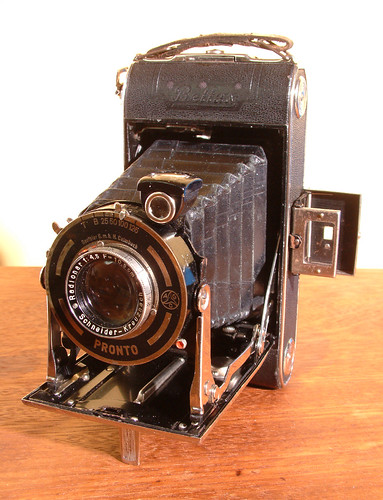Bettax

|
| Zeh Bettax (c1936) with a Radionar in a Pronto shutter. image by Dustin McAmera (Image rights) |
The Bettax is a folding camera made by Paul Zeh in Dresden in the 1930s. It takes eight images 2¼ x 3¼ inches on 120 film, and can be adjusted for sixteen half-frame pictures with a removable mask[1]. McKeown lists two models, one dated to about 1931, and also sold as the Bobby, and the other (as pictured) about 1936. The main differences between the models appear to be minor ones of style, and perhaps the use of more modern rim-set shutters in the later model. As often with folding cameras, a wide range of lens and shutter combinations was available: from Zecanar and Radionar triplets in simple shutters as pictured, to Tessar or Xenar in Prontor, Prontor II or Compur shutters.
The later model has a folding reverse-galilean viewfinder on the body as well as a Brilliant finder. Some examples have crosspieces in the viewfinder to show the half-frame view. It has a film winding key rather than a knob. Inside the film chamber, there are swing-out spool-holders at each end. The red window has a sliding cover. There are ⅜ inch tripod sockets on the side (at the opposite end from the key) and on the underside of the front door/lens bed. There is a spring suggesting that the camera should be self-erecting, though the example examined does not self-erect.
Like the Zeh Goldi, the later Bettax model was also supplied to Rodenstock, who sold it as the Weral or Werol[2]. A Rodenstock Ysar was one of the lenses available on the Zeh camera.
- Dimensions (height x width x depth): 166 x 90 x 45 mm (folded); depth unfolded = 128 mm.
- Weight (without film): 630 g